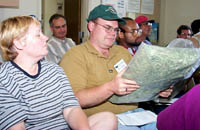Cut Forages Early to Maximize Use And Quality
Cut Forages Early to Maximize Use And Quality

Most producers ultimately are concerned with their bottom line. Correctly managing forages and legumes can optimize the production, profit and quality of a hay crop. On May 18 at Kentucky State University's Research Farm, Extension specialists from the University of Kentucky College of Agriculture and KSU discussed ways to optimize forages and legumes to meet the nutritional needs of livestock.
Jimmy Henning, UK forage specialist, said many producers frequently pay more attention to the livestock part of their enterprise than to pastures and stored forages and that can result in reduced plant and animal productivity.
UK Beef Specialist, John Johns, emphasized the importance of getting hay cut early.
"If you want to be one of the folks that all you need is a complete mineral supplement, you better already have your hay rolled up," he said. " If you don't, you're going to certainly need an energy supplement and maybe a protein supplement."
Many times, producers put off cutting hay because they are concerned about rain and the hay getting wet in the field. But, Johns and Henning agree there is no guarantee that it won't rain in 30 days. It's better to have wet hay, cut on time, than to have late-cute hay.
In cattle, the difference between feeding early and late-cut hay is substantial. Mature hay will pass through the cow slower, so the cow eats and digests less, resulting in lower gain and performance.
"You don't make more pounds of growth on mature hay, you make more pounds of manure because digestibility and intake go down the later the hay is cut," Johns said. "The number of calves and their weight gain is directly related to forage quality. Forage quality is directly related to when you harvest it."
Late-cut hay loses digestibility and nutritional quality, as well as trace mineral value.
"Mineral deficiencies can be a problem. Angus can get a red-tinged hair color from a copper deficiency. With severe deficiencies you can see breeding, fertility and immunity problems," Patty Scharko, Extension veterinarian for the UK Livestock Disease Diagnostic Center, said.
"If your calves are about two-to-three months old, it's ideal to give black leg vaccines right now. If the animal is ready to receive it, about 90 percent will respond, but if the animal is deficient in copper or selenium it will lower that percentage."
With tobacco quota cuts, producers may try to run more cattle to supplement lost income. Since cattle prices are good right now, it may only take an additional eight head of cattle to replace cash flow from one acre of tobacco. But, if prices drop again, it will take more. Johns said that cattle producers can run more cattle if they efficiently manage their forages.
Another outlet for forage crops is one that may not be at the top of cattle producers minds. Kentucky has a giant market available in horse owners.
"Many horse owners in Kentucky have a small number of horses," Bob Coleman, UK equine specialist, said. "They're looking for a small amount of hay and that might be an opportunity for cattle producers to add income to their enterprise."
Coleman said owners of small numbers of horses may be new to the industry and need some help when purchasing hay. While horse owners know they need hay, they may not know what kind is best for their horses. Many know they should be concerned about mold content in the hay, but they don't know how to identify it.
Moisture content is very important to horse owners, since mold can be very detrimental to a horse's health.
"My rule of thumb is if the moisture content is above 16.5 percent, there's a good chance it's going to start to mold, Coleman said. "For cattle that might not be a major concern but horses have to be able to breathe correctly to be of any use."
Mold causes a condition called heeves, which affects lung tissue, resulting in a horse that can no longer properly exhale, you can't fix it. Look for mold when purchasing hay and don't feed it to horses if mold is present.
Johns said cattle are not as susceptible to some toxins as other animals.
"The big problem with moldy feed is that it cuts down on feed intake which will cut down on performance. So you don't want to feed moldy feed to cattle either," he added.
It is hard to predict the nutrient content of hay, however, people who use large amounts of hay in feeding their animals – cattle or horses – should get the hay analyzed. This means using a hay probe to get a proper sample. Probes are available from county Extension offices or the Kentucky Department of Agriculture's Hay Testing program.
As with any crop, many factors are involved in producing quality forages, but the most important arguably is harvest time. Hay cut on time will reduce costs of supplements. Cows will gain more on optimum forage. Horse owners will feel safer buying good quality hay.
"If there's one thing you can do to reduce your feed costs, it's to cut your hay when it needs to be cut, plain and simple," Johns said.
Kentucky State University and the Kentucky Cooperative Extension Service host a day-long meeting on the third Thursday of each month. In June, the emphasis will be on aquaculture. For more information on the Third Thursday Thing, call Marion Simon at KSU (502) 227-6327.